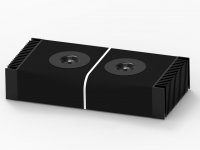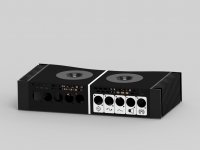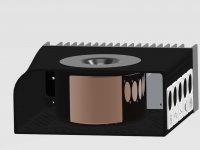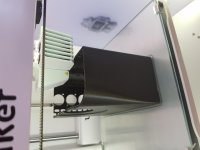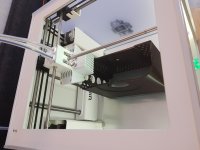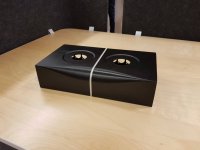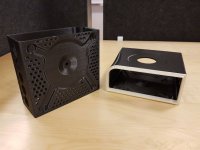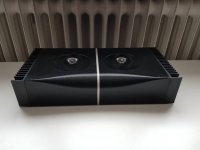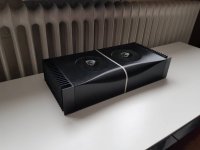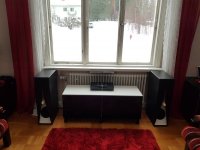I am currerntly 3d printing a housing for 2 velleman k8060 (to replace my current ta2020 lepai). The rms needed is about 25w so i will keep everything original. I will print left and right side separately and join them with a white line.
Here are some picutres of the 3d model as well as the ongoing printing in action. i am not sure if i will add the labels on the connectors or not yet. so took one side with and one without.
Please let me know your thoughts. Also, I don't know the right place to post, or if it even deserves a tread, so please let me know where i should post this.
Here are some picutres of the 3d model as well as the ongoing printing in action. i am not sure if i will add the labels on the connectors or not yet. so took one side with and one without.
Please let me know your thoughts. Also, I don't know the right place to post, or if it even deserves a tread, so please let me know where i should post this.
Attachments
Last edited:
Looks nice, but will you not run into problems with EMI ? Dont know, just curious. Normaly the case is also a shield when made out of metal...
I've built and worked on a few integrated amplifiers and preamps mounted in plastic cases. In some situations, such as in homes where there aren't many noisy appliances, you can enjoy quiet operation when using low audio levels (think of the transistor radio, clock radios, boom boxes etc.) but for hi-fi systems, even the refrigerator thermostat, nearby power tools, energy systems and kitchen appliances can become quite audible via unshielded circuits.
If you are committed to 3D print construction, also bear in mind the suitability and strength of the plastic material for mounting heavy and potentially hot items like power transformers and heatsinks. The single bolt mounting of a toroidal transformer will likely be a concern. Also, very few thermoplastics are rated to safely house power devices for use with both mains power and potentially hot items. Fire hazard and toxic gas emissions are just a couple of the problems.
The typical plastic filament used is ABS which has been used for the exterior of many electrical appliances (beige boxes) where fabrication was by injection moulding of specified grades. Engineering allowances would have been made for reinforcement around attachment points and adequate airflow assured by design.
You'll probably need to know quite a bit more about materials engineering if you expect to make a safe and serviceable enclosure by DIY. Metals are flexible and easy to design with, having a long history and pictorial records behind them. Plastics may now be everywhere but few people know much about them at all, so take care and make sure you use a suitable grade and thicknesses for strength and suitable for use with mains voltages at potentially high temperatures.
If you are committed to 3D print construction, also bear in mind the suitability and strength of the plastic material for mounting heavy and potentially hot items like power transformers and heatsinks. The single bolt mounting of a toroidal transformer will likely be a concern. Also, very few thermoplastics are rated to safely house power devices for use with both mains power and potentially hot items. Fire hazard and toxic gas emissions are just a couple of the problems.
The typical plastic filament used is ABS which has been used for the exterior of many electrical appliances (beige boxes) where fabrication was by injection moulding of specified grades. Engineering allowances would have been made for reinforcement around attachment points and adequate airflow assured by design.
You'll probably need to know quite a bit more about materials engineering if you expect to make a safe and serviceable enclosure by DIY. Metals are flexible and easy to design with, having a long history and pictorial records behind them. Plastics may now be everywhere but few people know much about them at all, so take care and make sure you use a suitable grade and thicknesses for strength and suitable for use with mains voltages at potentially high temperatures.
I've built and worked on a few integrated amplifiers and preamps mounted in plastic cases. In some situations, such as in homes where there aren't many noisy appliances, you can enjoy quiet operation when using low audio levels (think of the transistor radio, clock radios, boom boxes etc.) but for hi-fi systems, even the refrigerator thermostat, nearby power tools, energy systems and kitchen appliances can become quite audible via unshielded circuits.
If you are committed to 3D print construction, also bear in mind the suitability and strength of the plastic material for mounting heavy and potentially hot items like power transformers and heatsinks. The single bolt mounting of a toroidal transformer will likely be a concern. Also, very few thermoplastics are rated to safely house power devices for use with both mains power and potentially hot items. Fire hazard and toxic gas emissions are just a couple of the problems.
The typical plastic filament used is ABS which has been used for the exterior of many electrical appliances (beige boxes) where fabrication was by injection moulding of specified grades. Engineering allowances would have been made for reinforcement around attachment points and adequate airflow assured by design.
You'll probably need to know quite a bit more about materials engineering if you expect to make a safe and serviceable enclosure by DIY. Metals are flexible and easy to design with, having a long history and pictorial records behind them. Plastics may now be everywhere but few people know much about them at all, so take care and make sure you use a suitable grade and thicknesses for strength and suitable for use with mains voltages at potentially high temperatures.
Thanks for your input and I share your concerns. This is printed in pla, witch is worse then abs from a strength point of view, as well as lower melting point.
The reason for my choices are based on what I had laying around, and I thought this would be a better alterative than just mounting everything to a piece of plywood and hiding it in the TV bench drawer. It will not leave my home and i have no commercial interest.
K8060
I like your choice of apm kit K8060.
Well now it's done and up and running. From a mini DSP hd directly in to the k8060 without any volume control in between. So far so good. No noticable noice unless you put your ear against the Tweeter.View attachment 735127View attachment 735128View attachment 735129
I like your choice of apm kit K8060.
- Status
- Not open for further replies.
- Home
- Design & Build
- Construction Tips
- 3d printed Velleman k8060
